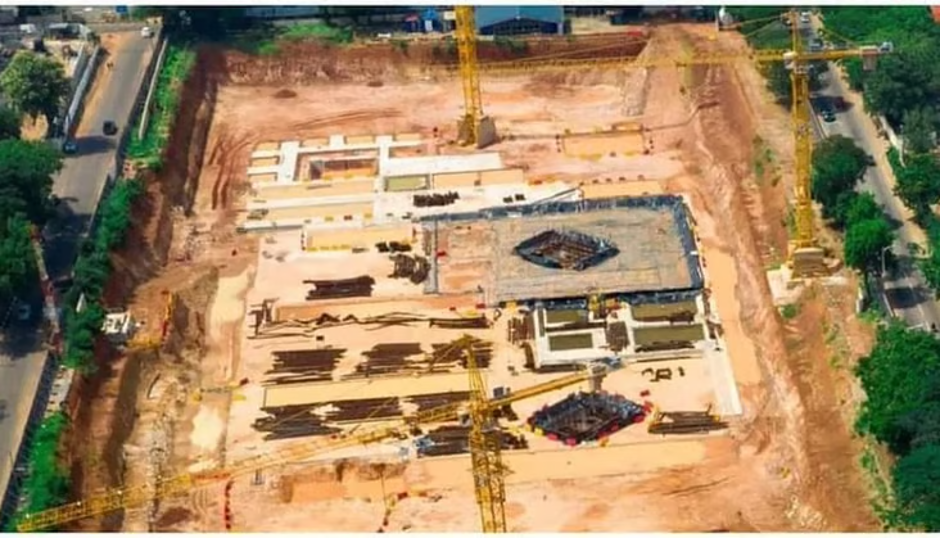
Photo: The $97 million crater of a cathedral
Just 700 metres from Ghana’s Parliament House, a gaping crater sits idle—weed-choked, eerily quiet, and symbolising what many now call the nation’s most expensive mistake. Into this lifeless pit, $97 million of public funds have disappeared, sunk in the name of a National Cathedral that never rose beyond its controversial foundations.
Once celebrated as a grand vision of faith and unity, the now-abandoned site has become the starkest emblem of what critics say is fiscal recklessness, executive overreach, and misplaced national priorities under President Nana Addo Dankwa Akufo-Addo’s administration.
The Holy Dream
Unveiled in 2018, the National Cathedral was meant to be a shining monument to Ghana’s religious heritage and global standing. The government promised:
• A 5,000-seat, two-tier auditorium expandable to 15,000;
• Africa’s first Bible Museum and Documentation Centre;
• A music school, national crypt, art gallery, library, banquet hall, and a 350-seater restaurant.
It was to host presidential inaugurations, national prayer days, and state funerals—offering both sacred purpose and economic potential, the government said.
But as economic hardship deepened, the dream took on a darker hue.
A Cathedral Funded by Crisis
In 2022, Ghana’s inflation spiked to a 21-year high of 54%. The cedi lost value by the day. Fuel prices skyrocketed. Public debt ballooned. The Ghana Statistical Service and UNDP reported that nearly a quarter of Ghanaians had fallen below the poverty line.
Yet amid this bleak landscape, the Akufo-Addo government quietly continued to channel millions into the project—largely from public funds, and with limited parliamentary oversight.
The $97 Million Bombshell
The real cost came to light on July 18, 2025, when Minister of Government Communications, Felix Kwakye Ofosu, revealed that the project had drained $97 million, contrary to earlier estimates of $58 million.
An audit ordered by President John Dramani Mahama and conducted by Deloitte and Touche uncovered that an additional $39 million remains owed to the main contractor. What makes this figure more jarring is the near-absence of tangible progress at the site.
“What exists today is not a national cathedral. It’s a $97 million hole,” Kwakye Ofosu stated.
A Pit of Poor Accounting
The audit further revealed staggering financial mismanagement:
• Payments made without documentation.
• No receipts for board expenses, symposiums, or office costs.
• Missing financial records for substantial transactions.
“The failure of management to produce documents to support several transactions is deeply troubling,” Kwakye Ofosu added.
Meanwhile, construction has stalled for years, even as daily penalties continue to rack up under the project’s punitive contractual terms.
More Vanity Than Vision
Supporters insist the project would one day draw pilgrims and faith-based tourists, yielding long-term benefits. But critics argue that it has become the ultimate white elephant—a monument to hubris rather than holiness.
In a nation where classrooms lack desks, clinics lack beds, and towns lack clean water, the image of nearly $100 million evaporating into a ceremonial ditch has fuelled public anger.
Religious leaders have distanced themselves. Civil society groups have demanded accountability. And many Ghanaians see the hole as a metaphor for the nation’s governance failures—deep, expensive, and empty.
A National Monument to Misplaced Priorities
Today, no cathedral graces the skyline. No museum educates visitors. No jobs have materialised. Instead, the site sits as a sobering reminder of what happens when public resources are thrown after executive ambition.
“It may be sacred ground in spirit,” one resident remarked, “but it’s a $97 million tombstone for truth and trust in government.”
As calls grow for full accountability, the National Cathedral project may go down not as a symbol of national faith, but as one of Ghana’s most telling cautionary tales.






